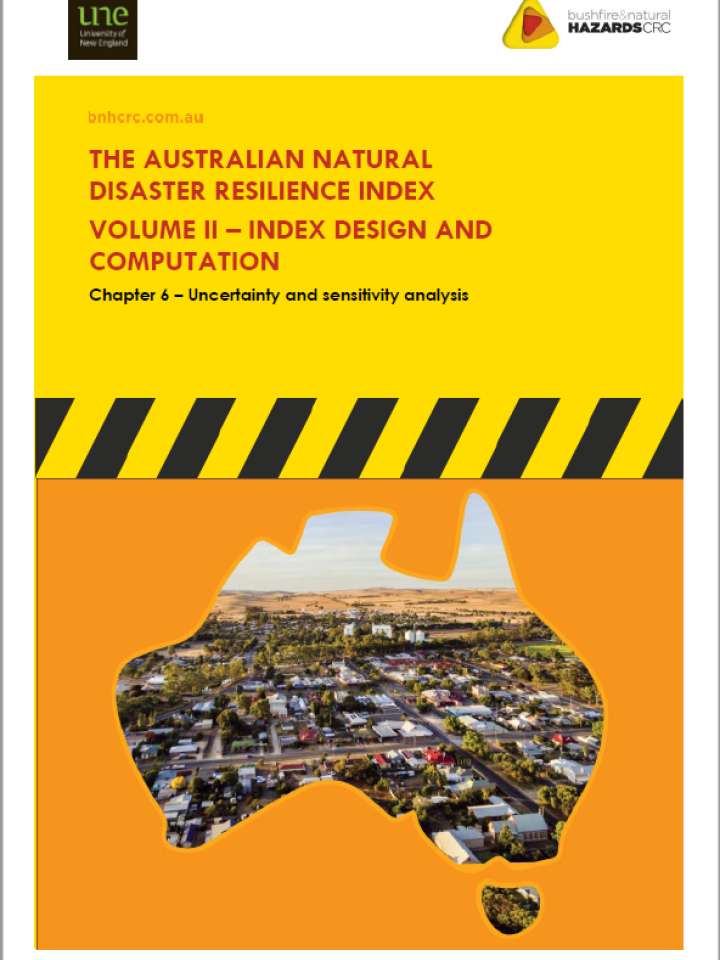The Australian Natural Disaster Resilience Index: Volume II
Australian communities face increasing losses and disruption from natural disasters. Disaster resilience is a protective characteristic that acts to reduce the effects of, and losses from, natural hazard events. Disaster resilience arises from the capacities of social, economic and government systems to prepare for, respond to and recover from a natural hazard event, and to learn, adapt and transform in anticipation of future natural hazard events. This assessment of disaster resilience estimates the status of these capacities and shows how they are spatially distributed across Australia.
Composite indices are frequently used to summarize and report complex relational measurements about a particular issue. The Australian Natural Disaster Resilience Index measures disaster resilience as a set of coping and adaptive capacities. Coping capacity is the means by which available resources and abilities can be used to face adverse consequences that could lead to a disaster. Adaptive capacity is the arrangements and processes that enable adjustment through learning, adaptation and transformation. Eight themes of disaster resilience encapsulate the resources and abilities that communities have to prepare for, absorb and recover from natural hazards (social character, economic capital, emergency services, planning and the built environment, community capital, information access) or to adapt, learn and solve problems (social and community engagement, governance and leadership). Across the eight themes, 77 indicators were used to compute the Australian Natural Disaster Resilience Index in 2084 areas of Australia, corresponding to the Statistical Area Level 2 divisions of the Australian Bureau of Statistics.
The index was then used to undertake the first nationally standardised assessment of the state of disaster resilience in Australia. Disaster resilience is reported at three levels: an overall disaster resilience index, coping and adaptive capacity sub-indexes and themes of disaster resilience that encapsulate the resources and abilities that communities have to prepare for, absorb and recover from natural hazards and to adapt, learn and solve problems (social character, economic capital, emergency services, planning and the built environment, community capital, information access, social and community engagement, governance and leadership).
Volume II (this volume) describes in detail the computation of the Australian Natural Disaster Resilience Index. This includes resilience concepts, literature review, index structure, data collection, indicators, statistical methods, detailed statistical outputs, sensitivity analysis and uncertainty analyses.
Readers interested in the technical aspects of the Australian Natural Disaster Resilience Index should also consider Volume II. Volume II is comprised of six chapters:
Chapter 1: Design of the Index
- Section 1.1 Presents the conceptual basis of the Australian Natural Disaster Resilience Index.
- Section 1.2 Describes the structure of the index, including its hierarchical structure, and the themes of disaster resilience.
- Section 1.3 Outlines the spatial resolution and areas of Australia included in the index.
Chapter 2: Indicators
- Section 2.1 Describes the method used to identify and select indicators for the Australian Natural Disaster Resilience Index.
- Section 2.2 Lists the indicators used in the index themes, including the source of each indicator and how it was calculated.
- Section 2.3 Justifies the relationships between indicators and disaster resilience for each theme in the index, using a literature review.
- Section 2.4 Describes the method used to disaggregate some of the indicators to an SA2 resolution.
Chapter 3: Computation of the Australian Natural Disaster Resilience Index
- Section 3.1 Reviews the development and use of composite indexes and methods for computing composite indexes.
- Section 3.2 Describes the rationale for, and the statistical computation of, the Australian Natural Disaster Resilience Index.
- Section 3.3 Describes the methods used to compute the typology of groups of SA2s with similar disaster resilience profiles.
Chapter 4: Statistical outputs: ANDRI, coping capacity and adaptive capacity
- Section 4.1 Presents the statistical outputs and results for the overall Australian Natural Disaster Resilience Index.
- Section 4.2 Presents the statistical outputs and results for the coping capacity index.
- Section 4.3 Presents the statistical outputs and results for the adaptive capacity index.
Chapter 5: Statistical outputs: disaster resilience themes
Each section presents the statistical outputs and results of one disaster resilience theme.
- Section 5.1 Social character.
- Section 5.2 Economic capital.
- Section 5.3 Emergency services.
- Section 5.4 Planning and the built environment.
- Section 5.5 Community capital.
- Section 5.6 Information access.
- Section 5.7 Social and community engagement.
- Section 5.8 Governance and leadership
Chapter 6: Uncertainty and sensitivity analysis
- Section 6.1 Explains the role of uncertainty and sensitivity analysis in composite index construction.
- Section 6.2 Describes the uncertainty analysis applied to the Australian Natural Disaster Resilience Index.
- Section 6.2 Describes the sensitivity analysis applied to the Australian Natural Disaster Resilience Index.
Explore further
